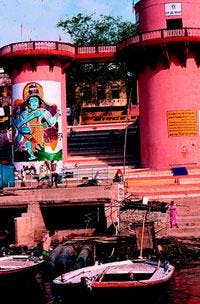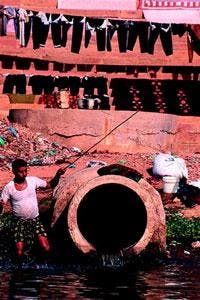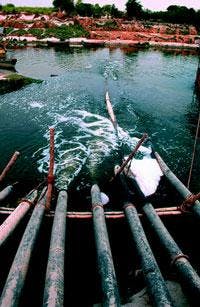By Anil Agarwal and Sunita Narain
Drainage water is discharged into rivers used by city residents.
Private sector involvement in municipal water systems should be extremely limited in India given the political economy of water and sewerage. Lucrative business opportunities in the water sector, however, are attracting great attention from Indian companies. The Confederation of Indian Industry (CII) and other associations are competing with each other to establish a fair share of this growing market created by the huge investments required for drinking water and sanitation.
Community, industry and government must work together to improve water management and these basic services. Private sector involvement cannot solve the world's water crises. Private sector proponents contend that if water were correctly priced - what is known as full cost pricing - it would facilitate investment from the private sector and provide a solution to the water crisis facing vast regions of the developing world. This argument is riddled with holes.
First, current water and sanitation technology based on the flush toilet and sewage system would make full cost pricing of water and sanitation services unaffordable by most in urban South India. Private sector involvement cannot be only in the water supply business; this is just one small and profitable part of the water business. The real cost is in collecting sewage and treating it to the quality needed for disposal in water bodies. This is the real "dirty" business. Sewage and drainage costs can be five to six times more than the cost of water supply. Industrial wastes, including chemicals and other contaminants, will push water treatment costs higher.
No democratic government will admit that it cannot afford to invest in modern sewage systems for its citizens. Instead governments continue to subsidise the users of these systems, in the name of the poor, who would not be able to afford the systems otherwise. Almost all users of the flush toilet and its sewage system are the rich in our cities. Our political system literally subsidises the rich to excrete in convenience. Surface water pollution caused primarily from domestic sewage disposal is then cleaned through costly river action programmes. Sewage treatment plants are funded through river clean-up programmes like the Ganga Action Plan, the Yamuna Action Plan or the National River Action Plan.
City resident stands in polluted river water near drainage discharge pipes.
The logical policy would be to accept the cost and then impose differential pricing so that the rich pay for capital- and resource-intensive sewage and waste disposal technology, and the poor pay for their low-cost disposal system, which is invariably unconnected to the sewerage system. This is difficult to achieve.
The democratic framework in our countries would force political leaders to keep water and waste pricing affordable by large sections of urban populations. Private investors, however, look for an easy way out. They prefer investing in water services and to leave the costly business of cleaning up the waste to government agencies. In most of the developing world, water companies are bidding and securing contracts primarily for the profitable water business. This will lead to price distortion, as profits will be creamed off, leaving wastewater treatment costs to the already strained public exchequer.
Second, the private sector will have little to offer the millions of urban poor residents in India. Most poor urban dwellers are illegal occupants living in slums and highly congested areas. The cost of reaching and maintaining services to these groups is expensive and recovery of investment is uncertain. The risks are high and the profits are low. Private investment is rarely available in this scenario.
Third, the private sector with its mantra of full cost pricing does not even begin to have answers for the millions of people living in rural India, who already pay an enormous cost for water. Community-based water systems, however, could solve water supply problems for rural dwellers. Given the state-dominated water supply systems, little effort has been made to get rural communities to develop and manage their own water supply systems. This approach achieved outstanding results in villages scattered across the country - Ralegan Siddhi, Sukhomajari, Bhikampura, Raj-Samadhiyala - to name just a few.
Rural communities contributed substantially by providing labour in the construction and maintenance of water supply systems. This approach reduces the cost of water supply to the public exchequer and gives ownership to project stakeholders - the community.
Rural Indians pay high costs for water in time and money.
Rural communities need financial support to facilitate self-management of water sources. Political decentralisation and empowerment can solve India's water supply problems, not full cost pricing.
A collaboration of community, industry and government is necessary to solve urban water supply problems. Public participation and political process that demands good governance in water management are key prerequisites for change- not another contractor.
Political economy of flush toilets, sewers questioned
Many argue that the flush toilet and sewage system is part of the environmental problem and not the solution. Consider the large amount of clean water that is used to carry even a small quantity of human excreta. In India, flushes are particularly wasteful. More than 10 litres of clean water goes down the drain with each flush. Huge dams and irrigation systems bring water to urban areas. This water, which is flushed down the toilet goes into an equally expensive sewage system, all to end up polluting more water - invariably rivers and ponds. Most of India's rivers are dead because of the domestic sewage load from cities. Our surface water systems are open sewage drains.
The political economy of sewer systems is simply atrocious for developing countries. It is virtually impossible for governments to catch up with the targets of building sewage treatment plants. Government programmes chase targets hopelessly and remain miles behind the volume of sewage being generated. In a rapidly urbanising situation, the city would soon outgrow the sewage treatment capacity created at a high cost.
For example, Yamuna is Delhi's main sewage drain. Yamuna enters Delhi at Wazirabad - where the city draws its water supply - and after this an estimated 1,800 million litres per day (mld) of untreated sewage flows through 18 drains into the river. In the last 40 years, the total sewage output increased rapidly. Untreated sewage grew even faster. In 1999, the Central Pollution Control Board estimated that Delhi produces over 2,547 mld of sewage of which only 885 mld is collected through the sewage network for treatment and the bulk - over 75% flows into stormwater drains and then into the river. By late 2000, treated sewage increased to 1,333 mld as had the quantity of sewage - still over 50% of the city sewage was dumped into the river. By 2005, Delhi plans to triple its present sewage treatment capacity at a cost of US$ 7.5 billion. But this will still be less than what is needed.
Even if Delhi builds all the sewage treatment plans, it will still not receive the sewage to treat. Why? The city's sewage drains are choked and silted. The government admits that the present capacity of the sewage treatment plants is not fully used and when it builds new treatment facilities, many times sewage never reaches these plants. Many sewer lines are choked, overloaded and broken. The sewage simply finds its way into stormwater drains and then into the river. According to government estimates, another US$ 5 billion is needed to refurbish the sewers. Expensive to build and even more expensive to run.
Authors' note
Sunita Narain, is director of the Centre for Science and Environment in New Delhi, India. The late Anil Agarwal, CSE chairperson until January 2002, contributed to this article. For more information on this topic and CSE activities, visit the website: www.cseindia.org






